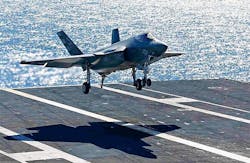Raytheon to pursue full-scale development of carrier-based GPS aircraft landing system
Officials of the Naval Air Systems Command at Patuxent River Naval Air Station, Md., announced their intention this week to award a sole source contract to the Raytheon Integrated Defense Systems business in Tewksbury, Mass. for the engineering and manufacturing development (EMD) portion of the Sea-Based Joint Precision Approach and Landing System (JPALS) GPS aircraft landing system program.
Sea-Based JPALS is an all-weather, all-mission GPS-based landing system that provides landing guidance for carrier-based fixed-wing aircraft and helicopters, and features anti-jam protection for operating in electronic warfare (EW) environments.
The EMD contract for Sea-Based JPALS will run from 2016 to 2022, and will include the design, development, manufacture, integration, demonstration, and test of the Sea-Based JPALS system.
Related: FAA certification sought for GPS-based aircraft precision-approach landing system
The contract will also include 13 engineering development model units and other weapons replaceable assemblies, developmental test and operational test support, and a technical data package.
Sea-Based JPALS works with the GPS satellite navigation system to provide accurate, reliable, and high-integrity guidance for carrier-based fixed-wing aircraft and helicopters. Sea-Based JPALS is a differential GPS that will provide an adverse weather precision approach and landing capability.
Differential GPS uses network of fixed-base reference stations to broadcast the difference between the positions indicated by the GPS signals and known fixed positions. A digital correction signal is broadcast locally over short-range fixed-based transmitters.
Using differential GPS technology improves satellite navigation and positioning accuracy from about 15 meters using non-enhanced GPS to about 4 inches with differential GPS.
story continues below
Navy officials say they plan for initial operating capability (IOC) for Sea-Based JPALS in 2019, and full-operational capability (FOC) in 2030. JPALS test landings aboard the aircraft carrier USS Theodore Roosevelt in late 2013.
Navy officials plan to award the contract to Raytheon sole-source, they say, because the company is the only responsible source. Raytheon is the original designer, developer, and manufacturer of the Sea-Based JPALS system, has been the system's prime contractor since 2008, and has completed the initial development work for the ship system.
Raytheon won a $232.8 million Navy contract in 2008 for Sea-Based JPALS system development and demonstration. For more information contact Raytheon Integrated Defense Systems online at www.raytheon.com, or Naval Air Systems Command at www.navair.navy.mil.
